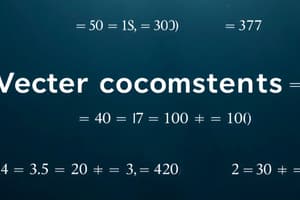Podcast
Questions and Answers
What is a unit vector?
What is a unit vector?
- A vector of unit magnitude in a specified direction (correct)
- A vector that can point in any direction with any magnitude
- A vector with zero magnitude
- A vector that has only one component
The unit vectors î, Ĵ, and k̂ are directed along the x, y, and z axes, respectively.
The unit vectors î, Ĵ, and k̂ are directed along the x, y, and z axes, respectively.
True (A)
What is the standard Cartesian form of representing a vector F in terms of its components?
What is the standard Cartesian form of representing a vector F in terms of its components?
F = Fx î + Fy Ĵ + Fz k̂
The unit vector that characterizes the direction of a force can be obtained by dividing the vector d by its magnitude d, resulting in the unit vector _____ .
The unit vector that characterizes the direction of a force can be obtained by dividing the vector d by its magnitude d, resulting in the unit vector _____ .
Match the following unit vectors with their corresponding axes:
Match the following unit vectors with their corresponding axes:
Which of the following statements about unit vectors is correct?
Which of the following statements about unit vectors is correct?
Multiplying a unit vector by a scalar will change its direction but not its magnitude.
Multiplying a unit vector by a scalar will change its direction but not its magnitude.
How can you obtain the unit vector n̂ in terms of vector d?
How can you obtain the unit vector n̂ in terms of vector d?
Which type of vector is used to represent a force acting on a specific particle?
Which type of vector is used to represent a force acting on a specific particle?
The cross product of two vectors that point in opposite directions is zero.
The cross product of two vectors that point in opposite directions is zero.
What is the primary characteristic that differentiates a free vector from other types of vectors?
What is the primary characteristic that differentiates a free vector from other types of vectors?
A vector is represented by the notation ____, which indicates its direction.
A vector is represented by the notation ____, which indicates its direction.
Match each type of vector to its description:
Match each type of vector to its description:
What is the notation typically used to express the magnitude of a vector?
What is the notation typically used to express the magnitude of a vector?
Two vectors that are perpendicular will have a non-zero cross product.
Two vectors that are perpendicular will have a non-zero cross product.
Define what a sliding vector is in terms of its application.
Define what a sliding vector is in terms of its application.
What are the rectangular components of a force vector known as?
What are the rectangular components of a force vector known as?
The orientation of the x- and y-axes affects the negativities of the components Fx and Fy.
The orientation of the x- and y-axes affects the negativities of the components Fx and Fy.
What is the formula to calculate the horizontal component (Fx) of a force based on its angle?
What is the formula to calculate the horizontal component (Fx) of a force based on its angle?
The vertical component of a force can be calculated using the formula ___ = Fsinθ.
The vertical component of a force can be calculated using the formula ___ = Fsinθ.
Which of the following statements about the rectangular components of a force is true?
Which of the following statements about the rectangular components of a force is true?
Match the force components with their corresponding formulas:
Match the force components with their corresponding formulas:
When both Fx and Fy are directed to the negative axes, they are still considered positive.
When both Fx and Fy are directed to the negative axes, they are still considered positive.
What information do the rectangular components of a force provide about that force?
What information do the rectangular components of a force provide about that force?
Flashcards are hidden until you start studying
Study Notes
Unit Vectors
- A unit vector has a magnitude of one and points in a specified direction.
- Multiplying a unit vector by a scalar results in a vector with the unit vector's direction and magnitude equal to the scalar.
- Standard unit vectors include:
- î: directed along the x-axis
- Ĵ: directed along the y-axis
- k̂: directed along the z-axis
- n̂: an arbitrary direction
Force Representation
- A force vector F can be expressed in Cartesian coordinates as:
- 𝐅 = 𝐹𝑥 𝐢̂ + 𝐹𝑦 𝐣̂ + 𝐹𝑧 𝐤
- The unit vector n̂ that defines the direction of force F is determined by dividing the vector d by its magnitude.
Vector Notation
- Vectors distinguish between magnitude and direction via notation:
- Represented as bold (F), with an arrow above (𝐹⃗ ), or underlined (F).
- Magnitude denoted by |F|.
Types of Vectors
- Fixed vector: Represents a force with a specific point of application.
- Sliding vector: Can move along the lines of action of forces acting on rigid bodies.
- Free vector: Independent of the point of application.
Rectangular Components
- Commonly used to resolve force vectors in two dimensions:
- Components can be calculated as:
- 𝐹𝑥 = 𝐹𝑐𝑜𝑠𝜃
- 𝐹𝑦 = 𝐹𝑠𝑖𝑛𝜃
- Components can be calculated as:
- Components Fx and Fy are positive in the direction of their respective axes, negative when directed oppositely.
Direction and Specification
- Knowing the rectangular components of a force completely determines its magnitude, inclination, and direction.
- The orientation of the x- and y-axes is arbitrary, thereby affecting the sign of the components.
Studying That Suits You
Use AI to generate personalized quizzes and flashcards to suit your learning preferences.




